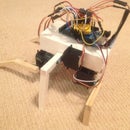Introduction: Arduino Gameboy
This is an awesome intractable on how to make your very own arduino gameboy! Its is fun and easy to make. You can bring it anywhere you want and play any game you want!
Attachments
Step 1: Putting the Circuit Together
Materials:
Arduino Uno
16x2 lcd screen
2 potentiometers
breadboard
solder-less breadboard
1. Connect the potentiometer to the lcd screen, and the screen to the arduino as shown in the schematic below.
Step 2: Finishing the Curcuit
1. Add in the second potentiometer to pin 1.
2. Attach the positive and negative wires to the correct pins on the arduino like shown below.
3. Mount everything on the breadboard.
Step 3: Put Everything Together
1. Cut out some cardboard with the correct mesurments for a case.
2. Glue (or tape) the pieces together and insert the circuit boards.
Step 4: Program Your Arduino Gameboy
There are many programs that you can download to this system. On of them is truck lane (not created by me but modified for this system)
The code is:
#include <LiquidCrystal.h>
// LiquidCrystal display
// initialize the library with the numbers of the interface pins
LiquidCrystal lcd(12, 11, 5, 4, 3, 2);
// Steering wheel potentiometer
const int POTPIN = 1;
const int MAXPOT = 800; // no need to turn the wheel all the way to 1023 :)
// Piezo speaker
const int SPEAKERPIN = 9;
const int RANDSEEDPIN = 0; // an analog pin that isn't connected to anything
const int MAXSTEPDURATION = 300; // Start slowly, each step is 1 millisec shorter.
const int MINSTEPDURATION = 150; // This is as fast as it gets
const int NGLYPHS = 6;
// the glyphs will be defined starting from 1 (not 0),
// to enable lcd.print() of null-terminated strings
byte glyphs[NGLYPHS][8] = {
// 1: car up
{ B00000,
B01110,
B11111,
B01010,
B00000,
B00000,
B00000,
B00000}
// 2: car down
,{B00000,
B00000,
B00000,
B00000,
B01110,
B11111,
B01010,
B00000}
// 3: truck up
,{B00000,
B11110,
B11111,
B01010,
B00000,
B00000,
B00000,
B00000}
// 4: truck down
,{B00000,
B00000,
B00000,
B00000,
B11110,
B11111,
B01010,
B00000}
// 5: crash up
,{B10101,
B01110,
B01110,
B10101,
B00000,
B00000,
B00000,
B00000}
// 6: crash down
,{B00000,
B00000,
B00000,
B10101,
B01110,
B01110,
B10101,
B00000}
};
const int NCARPOSITIONS = 4;
// Each position is mapped to a column of 2 glyphs
// Used to make sense when I had a 5th position
// where car or crash was drawn as 2 glyphs
// (can't do that since 0 terminates strings),
// so it's kinda silly now, but it ain't broke :)
const char BLANK=32;
char car2glyphs[NCARPOSITIONS][2] = {
{1,BLANK},{2,BLANK},{BLANK,1},{BLANK,2}
};
char truck2glyphs[NCARPOSITIONS][2] = {
{3,BLANK},{4,BLANK},{BLANK,3},{BLANK,4}
};
char crash2glyphs[NCARPOSITIONS][2] = {
{5,BLANK},{6,BLANK},{BLANK,5},{BLANK,6}
};
const int ROADLEN = 15; // LCD width (not counting our car)
int road[ROADLEN]; // positions of other cars
char line_buff[2+ROADLEN]; // aux string for drawRoad()
int road_index;
int car_pos;
// Off-the-grid position means empty column, so MAXROADPOS
// determines the probability of a car in a column
// e.g. 3*NCARPOSITIONS gives p=1/3
const int MAXROADPOS = 3*NCARPOSITIONS;
int step_duration;
int crash; // true if crashed
unsigned int crashtime; // millis() when crashed
const int CRASHSOUNDDURATION = 250;
const char *INTRO1="Trucks ahead,";
const char *INTRO2="Drive carefully";
const int INTRODELAY = 2000;
void setup()
{
crash = crashtime = road_index = 0;
step_duration = MAXSTEPDURATION;
line_buff[1+ROADLEN] = '\0'; // null terminate it
randomSeed(analogRead(RANDSEEDPIN));
for (int i=0; i<NGLYPHS; i++) {
lcd.createChar(i+1,glyphs[i]);
}
for (int i=0; i<ROADLEN; i++) {
road[i]=-1;
}
pinMode(SPEAKERPIN,OUTPUT);
analogWrite(SPEAKERPIN,0); // to be on the safe side
lcd.begin(16,2);
getSteeringWheel();
drawRoad();
lcd.setCursor(1,0);
lcd.print(INTRO1);
lcd.setCursor(1,1);
lcd.print(INTRO2);
delay(INTRODELAY);
}
void loop() {
unsigned long now = millis()-INTRODELAY;
if (!crash) {
getSteeringWheel();
crash = (car_pos==road[road_index]);
}
if (crash) {
if (!crashtime) {
crashtime=now;
drawRoad();
// Game over text
// (keep first 2 "crash" columns intact)
lcd.setCursor(2,0);
lcd.print("Crashed after");
lcd.setCursor(2,1);
lcd.print(now/1000);
lcd.print(" seconds.");
}
if ((now-crashtime)<CRASHSOUNDDURATION) {
analogWrite(SPEAKERPIN,random(255)); // white noise
}
else {
analogWrite(SPEAKERPIN,0); // dramatic post-crush silence :)
}
delay(10); // Wait a bit between writes
}
else {
int prev_pos = road[(road_index-1)%ROADLEN];
int this_pos = random(MAXROADPOS);
while (abs(this_pos-prev_pos)<2) { // don't jam the road
this_pos = random(MAXROADPOS);
}
road[road_index] = this_pos;
road_index = (road_index+1)%ROADLEN;
drawRoad();
delay(step_duration);
if (step_duration>MINSTEPDURATION) {
step_duration--; // go faster
}
}
}
void getSteeringWheel() {
car_pos = map(analogRead(POTPIN),0,1024,0,NCARPOSITIONS);
}
void drawRoad() {
for (int i=0; i<2; i++) {
if (crash) {
line_buff[0]=crash2glyphs[car_pos][i];
}
else {
line_buff[0]=car2glyphs[car_pos][i];
}
for (int j=0; j<ROADLEN; j++) {
int pos = road[(j+road_index)%ROADLEN];
line_buff[j+1] = pos>=0 && pos<NCARPOSITIONS ? truck2glyphs[pos][i] : BLANK;
}
lcd.setCursor(0,i);
lcd.print(line_buff);
}
}

Participated in the
Full Spectrum Laser Contest

Participated in the
Arduino Contest














